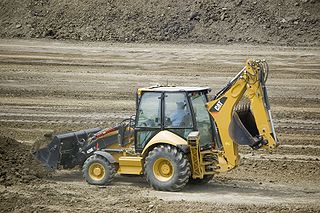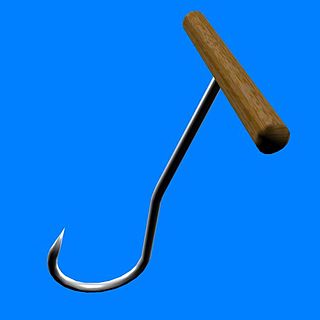
Hay is grass, legumes, or other herbaceous plants that have been cut and dried to be stored for use as animal fodder, either for large grazing animals raised as livestock, such as cattle, horses, goats, and sheep, or for smaller domesticated animals such as rabbits and guinea pigs. Pigs can eat hay, but do not digest it as efficiently as herbivores do.

A tractor is an engineering vehicle specifically designed to deliver a high tractive effort at slow speeds, for the purposes of hauling a trailer or machinery such as that used in agriculture, mining or construction. Most commonly, the term is used to describe a farm vehicle that provides the power and traction to mechanize agricultural tasks, especially tillage, and now many more. Agricultural implements may be towed behind or mounted on the tractor, and the tractor may also provide a source of power if the implement is mechanised.

A skid loader, skid-steer loader (SSL), or skidsteer is any of a class of compact heavy equipment with lift arms that can attach to a wide variety of buckets and other labor-saving tools or attachments.

A forklift is a powered industrial truck used to lift and move materials over short distances. The forklift was developed in the early 20th century by various companies, including Clark, which made transmissions, and Yale & Towne Manufacturing, which made hoists.

Silage is fodder made from green foliage crops which have been preserved by fermentation to the point of souring. It is fed to cattle, sheep and other ruminants. The fermentation and storage process is called ensilage, ensiling, or silaging. The exact methods vary, depending on available technology, local tradition and prevailing climate.

A loader is a heavy equipment machine used in construction to move or load materials such as soil, rock, sand, demolition debris, etc. into or onto another type of machinery.

A backhoe loader, also called a loader backhoe, loader excavator, tractor excavator, digger or colloquially shortened to backhoe within the industry, is a heavy equipment vehicle that consists of a tractor-like unit fitted with a loader-style shovel/bucket on the front and a backhoe on the back. Due to its (relatively) small size and versatility, backhoe loaders are very common in urban engineering and small construction projects as well as developing countries. This type of machine is similar to and derived from what is now known as a TLB (Tractor-Loader-Backhoe), which is to say, an agricultural tractor fitted with a front loader and rear backhoe attachment.

Heavy equipment, heavy machinery, earthmovers, construction vehicles, or construction equipment, refers to heavy-duty vehicles specially designed to execute construction tasks, most frequently involving earthwork operations or other large construction tasks. Heavy equipment usually comprises five equipment systems: the implement, traction, structure, power train, and control/information.

The three-point hitch is a widely used type of hitch for attaching ploughs and other implements to an agricultural or industrial tractor. The three points resemble either a triangle, or the letter A. In engineering terms, three-point attachment is the simplest and the only statically determinate way of rigidly joining two bodies.

A baler or hay baler is a piece of farm machinery used to compress a cut and raked crop into compact bales that are easy to handle, transport, and store. Often, bales are configured to dry and preserve some intrinsic value of the plants bundled. Different types of balers are commonly used, each producing a different type of bale – rectangular or cylindrical, of various sizes, bound with twine, strapping, netting, or wire.

A trailer is an unpowered vehicle towed by a powered vehicle. It is commonly used for the transport of goods and materials.

A telescopic handler, also called a lull, telehandler, teleporter, reach forklift, or zoom boom, is a machine widely used in agriculture and industry. It is somewhat like a forklift but has a boom, making it more a crane than a forklift, with the increased versatility of a single telescopic boom that can extend forwards and upwards from the vehicle. The boom can be fitted with different attachments, such as a bucket, pallet forks, muck grab, or winch.

A tow hitch is a device attached to the chassis of a vehicle for towing, or a towbar to an aircraft nose gear. It can take the form of a tow ball to allow swiveling and articulation of a trailer, or a tow pin, or a tow hook with a trailer loop, often used for large or agricultural vehicles where slack in the pivot pin allows similar movements. Another category is the towing pintle used on military vehicles worldwide.

A hook is a hand tool used for securing and moving loads. It consists of a round wooden handle with a strong metal hook about 20 cm long projecting at a right angle from the center of the handle. The appliance is held in a closed fist with the hook projecting between two fingers.

Material handling equipment (MHE) is mechanical equipment used for the movement, storage, control, and protection of materials, goods and products throughout the process of manufacturing, distribution, consumption, and disposal. The different types of equipment can be classified into four major categories: transport equipment, positioning equipment, unit load formation equipment, and storage equipment.
A bucket is a specialized container attached to a machine, as compared to a bucket adapted for manual use by a human being. It is a bulk material handling component.

Quick couplers are used with construction machines to allow the rapid change of working tools or buckets and attachments on the machine. They remove the need to use hammers to manually drive out and insert the mounting pins for attachments. They also bring with them additional safety risks that must be overcome by careful design and manufacture, and proper use.
A Drum handler is a piece of mechanical equipment that is used to securely grip, lift and transport cylindrical modules such as steel drums, barrels, plastic drums and fiber drums. It has spring-loaded metal arms to create a tight and secure grip. This equipment is commonly used in chemical and petroleum industries, as well as industries that require shipping and storing of cylindrical modules.

A hook is a tool consisting of a length of material, typically metal, that contains a portion that is curved/bent back or has a deeply grooved indentation, which serves to grab, latch or in any way attach itself onto another object. The hook's design allows traction forces to be relayed through the curved/indented portion to and from the proximal end of the hook, which is either a straight shaft or a ring for attachment to a thread, rope or chain, providing a reversible attachment between two objects.


















